Can't Get No Satisfaction
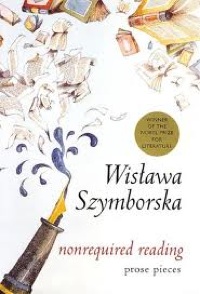
Endowed with modest talents, I have found it good practice to follow in the footsteps of giants. So in talking and writing (which is talking on the page) about books, I follow Nobel laureate Wislawa Szymborska’s lead. In her tome (which I recommend to anyone who presumes to be a book critic or reviewer) Nonrequired Reading (Harcourt), she explains:
Nonrequired Reading
She goes on to say that many of the reviewed books she found in bookstores were gathering dust, eventually being pulped. The ignored books seemed to be the ones that actually sold. She decided to review those books, but realized she really could not write reviews. Thus:
Basically I am and wish to remain a reader, an amateur and a fan, unburdened by the weight of ceaseless evaluation. I’m old fashioned and think that reading books is the most glorious pastime that humankind has yet devised.
Yeah, what she said.
* * *
I am not aware of many Israeli novelists that have made a big impact on the American cultural scrim—perhaps less than a handful. Not, say, for instance, like Cuban writers (from a culture that has much in common with Israel). No small wonder that Cubans have been labeled the Jews of the Caribbean.
But I digress.
David Grossman is one of those Israeli writers, having by the force of his body of work and numerous prestigious international awards drawn the attention of American literary gatekeepers. And in the case of his new opus To The End of the Land (Knopf), there has been a large groundswell of notices.
Wending from the present back to the Yom Kippur War and back to the present, Grossman has fabricated a dark and moving family drama upon the stage of an anti-war chronicle. No moral stance is taken lightly in the ever-rattling terrain of Israel and the Middle East.
* * *
I have said elsewhere, and it bears repeating, that I have learned more useful history from writers like Graham Greene, Alan Furst, Charles McCarry, John Lawton, and John Le Carré than from my undergraduate studies in history.
Le Carré has a new novel, Our Kind of Traitor (Viking), which focuses (as did his last novel, A Most Wanted Man) on the depredations and horrifying practices of national security services (M-6, CIA , KGB now called FSB/SVR, Mossad, and so on).
In this story, Dima, a high-level Russian money launderer, wants out. He approaches a British couple on holiday in Antigua to act as go-betweens. They contact the British authorities and attempt to set up a deal for Dima and family to defect to England. Whether this can or will happen is at the center of Le Carré’s plot, but not the catchy leitmotif, which is all about high-level corruption and avarice.
Dependably astute Tim Adams comments:
The here and now of the novel extends to having a chapter take place at the 2009 French Open tennis final between Roger Federer and Robin Söderling; this documentary strain sometimes feels like it is employed to give at least the atmosphere of verisimilitude to what threatens at times to be a somewhat dubious premise. Motivations are never entirely transparent in le Carré’s worlds—that is what gives his books their depth—but here what Hector calls the Infinite Law of Cornucopia—that “there are an infinite number of explanations for any single event… or you’ll never know which bugger hit you or why…”—does not always seem in the author’s masterly control.
Which is all right by me.
* * *
Apparently, the Scandinavians seem to have cornered the crime/thriller market. I suppose someone will take up an analysis of this trend, but in the meantime Between Summer’s Longing and Winter’s End: The Story of a Crime (Pantheon), written by Leif G.W. Persson and translated by Paul Norlen, adds to what may turn out to be a genre. (Not that I have noticed any textual commonality.)
This is the first book in a trilogy and is loosely tied to the unsolved 1986 assassination of Swedish Prime Minister Olof Palme, which reportedly triggered the biggest criminal investigation in recorded history. Persson is a expert criminologist, which deepens the verisimilitude of his writing.
* * *
Maira Kalman is an interesting and amusing writer/artist/designer whose work is often found in the pages of smart publications like The New Yorker and TheNew York Times. She continues to amuse and fascinate with such gems as her illustrated version of Strunk & White’s old warhorse, TheElements of Style.
The University of Pennsylvania’s Institute of Contemporary Art recently presented a Kalman exhibition. Maira Kalman: Various Illuminations(of a Crazy World) (Prestel), the catalogue attached to that traveling show, is a slim 144 pages, but chocked full with 120 color illustrations, with examples of her illustrated books for children, clocks she has designed, sets for the choreographer Mark Morris, fabrics for Maharam and Isaac Mizrahi, and many tables of many things selected from her life and studio.
* * *
Readers of creditable online publications and journals, and additional Bookforum, the New York Observer, and Congressional Quarterly should recognize Chris Lehmann’s name, which makes the subject matter and tone of his new tome Rich People Things (with illustrations by Peter Arkle) an expected pleasure.
In what he calls an impressionistic tract, Lehmann explains:
Rich People ThingsRich People Things
Also, Joshua David McDonald’s companion video is a hoot and a half.
* * *
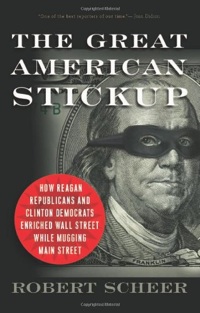
As long as I am perambulating on the vast terrain of oppositionist thinkers and activists, longtime burr-under-the-plutocratic saddle Truth Dig editor Robert Scheer’s Great American Stickup: How Reagan Republicans and Clinton Democrats Enriched Wall Street While Mugging Main Street (Nation Books) puts a clarifying explication to the great disservice done to the U.S. by both sides of the political fence. (My buddy Barry Crimmins used to joke that the only reason there weren’t three political parties was because corporations were not willing to write three checks.) The book’s subtitle, which he also calls “The Clinton Bubble,” tells you Scheer’s focus.
Chris Hedges (Empire of Illusion) elaborates:
Robert Scheer, one of our most brilliant journalists, shows how we have been fleeced by Wall Street and our bankrupt political class. Those in the halls of Congress, the White House, the Federal Reserve, the Treasury Department and the corporate offices of high finance have ignored the common good, trashed the economy, set us on a course for another economic shipwreck and looted the U.S. Treasury of trillions of taxpayer dollars to sustain a system of casino capitalism.
* * *
The call of ages gone by is a seductive one—for practical purposes, as remote as the made-up world of stories and novels. The Book in The Renaisance by Scottish history mentor Andrew Pettegree (Yale University Press) offers a wide-angle view of the first 150 years of printing, its impact, and the complexities of that impact.
Robert Pinsky offers this insight:
The humanist mythology of print. With this phrase, the British scholar Andrew Pettegree indicates the cultural story his book amends, and to some extent transforms. In an understated, judicious manner, he offers a radically new understanding of printing in the years of its birth and youth. Print, in Pettegree‚’s account, was never as dignified or lofty a medium as that humanist mythology of disseminated classics would suggest.
Obviously, this is not a book for every reader, but it is some kind of comfort that a scholar such as Pettegree has made one. Pinsky also notes:
In an appended “Note on Sources,” Pettegree allows himself to acknowledge that, ironically, it has been the next great information revolution, the internet, that has allowed this work on the first age of print to be pursued to a successful conclusion. Digital information newly available from all over the world enhanced his research on early print culture, in all its frequently vulgar, ephemeral, zany, and menacing variety.
* * *
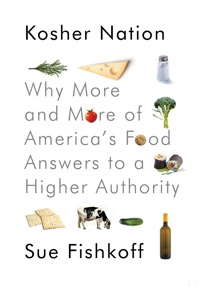
Food and health consciousness (not to mention regular food supply contaminations) have brought a hyper-scrutiny and nervous vigilance to the basic tasks of life.
Of course, the Chosen People have had such matters under control from time immemorial. Sue Fishkoff’s Kosher Nation: Why More and More of America’s Food Answers to a Higher Authority (Pantheon) makes clear laws of kashruth‚ as well as the contemporary influences in food production. (Factoid: 86 percent of the 11.2 million Americans who regularly buy kosher food are not observant Jews). Fishoff’s illuminating monograph covers a lot of bases: foodie, religious, cultural, and entrepreneurial. Interestingly, as Jenna Weissman Joselit points out:
If there is a central character in Fishkoff’s heavily populated account, it is not the businessmen who flog kosher food, the advertisers who promote it, the ritual specialists who kasher meat, the rabbis who encourage its observance or the housewives who keep a kosher kitchen, but the scientists, the chemists, and microbiologists who call the shots. When it comes to determining whether something is kosher, Jewish law and Jewish folk practice now play second fiddle to online databases and microscopes, chemistry, and microbiology. Years ago, you would take your chicken to your local rabbi to ascertain whether or not it was ritually permissible; today, it is inspected and duly certified by the lab before it even reaches the market.
* * *
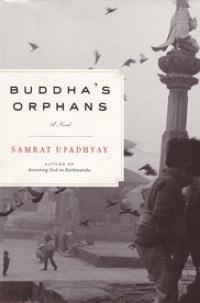
Who wouldn’t be curious about a book by a writer hailed as a “a Buddhist Chekhov”? Indiana University mentor Samrat Upadhyay’s (Arresting God in Kathmandu) newest novel, Buddha’s Orphans (Houghton Mifflin Harcourt), covers over half a decade of political upheaval in his native Nepal, somewhat in the spirit of Amitav Ghosh’s The Glass Palace.
Nepalese writer Kanak Mani Dixit observes:
The subject of the book is Kathmandu valley. His writings are imbued with Buddhist thoughts and deals with relationships, personalities, parenting, and 1970 era delicately put together. But I found the title of the book a bit inappropriate.
Upadhyay clarified, saying:
The Queen’s PondBuddha’s Orphans
* * *
Harvard University and U.C.L.A. scholar Irving Bernstein’s two definitive studies, initially published in 1960 (The Lean Years: A History of the American Worker, 1920-1933) and in 1969‚ (The Turbulent Years: A History of the American Worker, 1933-1941) have been republished by Haymarket Books. Given the irrational antipathy today’s workers have toward labor organizing, Bernstein’s surveys have an especially resonant message.
Frances Fox Piven (Regulating the Poor and Poor People’s Movements) introduces the two new volumes:
As the Great Depression took its toll in rapidly rising unemployment, wage cuts, worsening working conditions, and evictions and foreclosures, and even cases of actual starvation… most observers saw little evidence of a spirit of rebellion. In other words, viewed from afar, most of the people who were suffering the hardships of the Depression were depressed and even ashamed, ready to blame themselves for their plight. But the train of developments that connects changes in social conditions to a changed consciousness is not simple. People, including ordinary people, harbor somewhere in their memories the building blocks of different and contradictory interpretations of what it is that is happening to them, of who should be blamed, and what can be done about it. Even the hangdog and ashamed unemployed worker who swings his lunch box and strides down the street so the neighbors will think he is going to a job can also have other ideas that only have to be evoked, and when they are make it possible for him on another day to rally with others and rise up in anger at his condition.
* * *
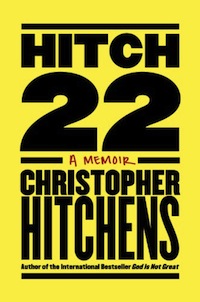
When Christopher Hitchens’s memoir Hitch 22 was freshly prominent in the current news cycle, I didn’t have anything new to add to the general clamor that surrounds the flamboyant and hyper-eloquent Hitch. Nor did I view much of the verbiage thoughtful and informative. Now comes Eric Alterman‚’s two-edged homage—worth reading however you value Hitchens—which begins:
Has there ever been anyone quite like Christopher Hitchens? As a writer and a thinker, Hitchens may be the greatest performance artist the profession has ever produced. He is Oscar Wilde without the plays; Gore Vidal without the novels; Edmund Wilson without the ideas; George Orwell without the integrity; and Richard Burton without the movies (and Elizabeth Taylor). What he is not, however, is the author of lasting works of reportage, criticism, philosophy, or, dare I say it, literature.
Fortunately, as one would expect, there was dissent:
Hitch-22
And so the battle rages on.
Please note: This week’s “Our Man in Boston” will be the column’s final installment on TMN. However, OMiB will resume shortly as a blog in a location to be announced (check this space), and plenty of Robert’s “Birnbaum Vs.” conversations are on deck to be published soon on TMN. Thank you—Eds.
